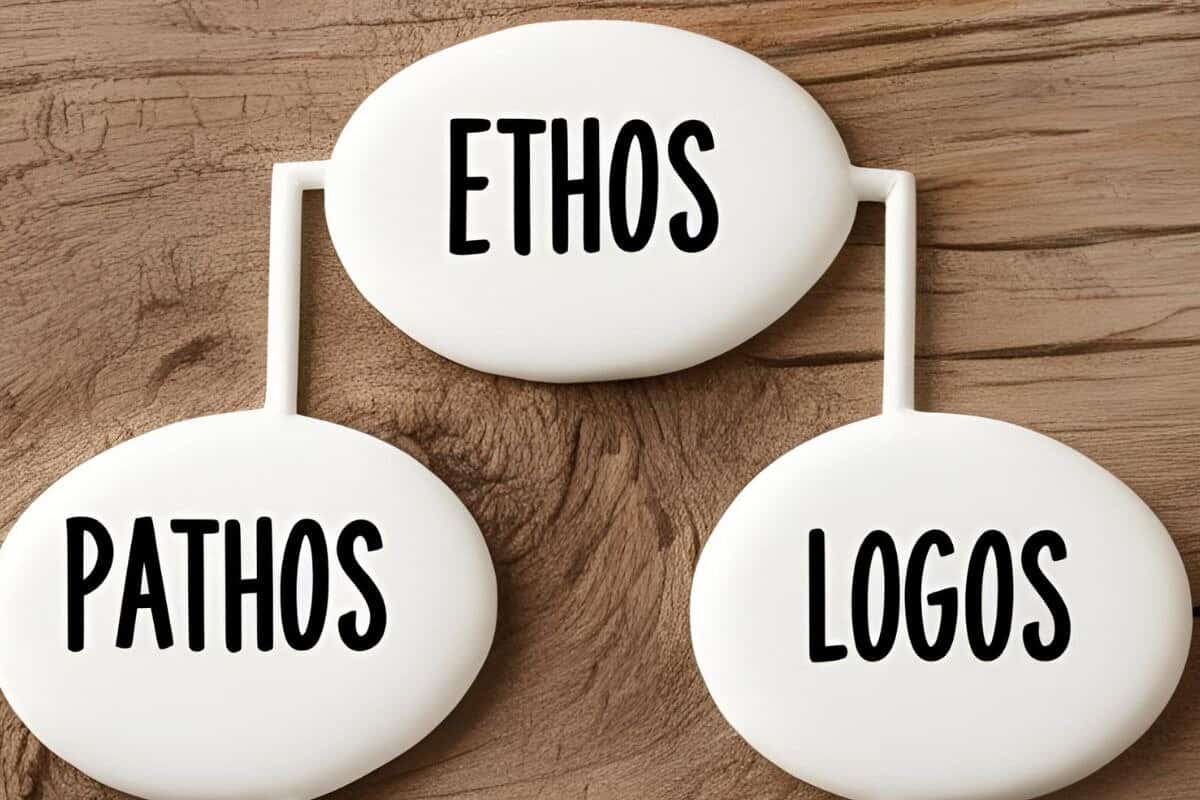We all have that one relative who most wins arguments at family gatherings.
The one whose opinion somehow becomes the final word… on everything from politics to how to cook a turkey.
People lean in when they talk. And before you know it, their take becomes the family decision.
Why is that?
Sure, it might just seem like they’ve got a way with words…
But if you look at it logically—they’re probably using a mix of ethos, pathos, and logos… without even realizing it!
They build trust with their confident tone and experience (ethos).
They touch your emotions with personal stories (pathos).
And they back it all up with just enough facts to make their case seem rock-solid (logos).
So what is ethos, pathos, and logos exactly? And how do they make conversations so compelling, so memorable… and just impossible to argue against?
In this blog, we’re covering the origin and definition of ethos, pathos, and logos, their comparison, how and when to use each one, real-world examples, and how AI can help you master these persuasive techniques.
Let’s dive in.
What Are Ethos, Pathos, and Logos?
Around 335 BCE, a Greek philosopher Aristotle wrote a book called “Rhetoric.” In it, he studied the way people talk when they want to persuade someone.
He watched how leaders, teachers, and storytellers spoke, and noticed something important: the most powerful speakers didn’t just use facts—they connected with people in different ways.
That’s when he came up with three tools of persuasion. They are called ethos, pathos, and logos.
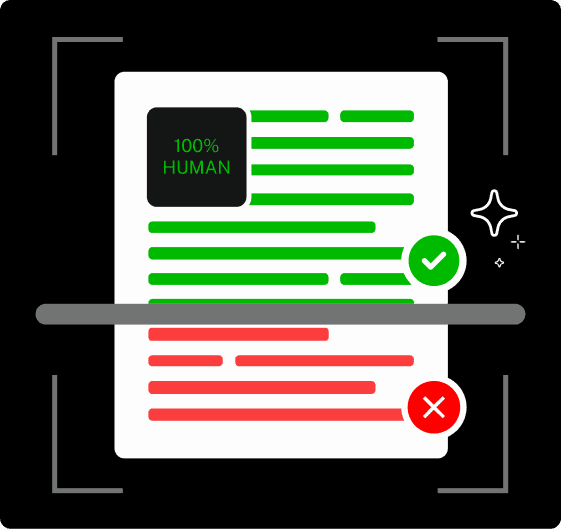

Never Worry About AI Detecting Your Texts Again. Undetectable AI Can Help You:
- Make your AI assisted writing appear human-like.
- Bypass all major AI detection tools with just one click.
- Use AI safely and confidently in school and work.
So, what is pathos, logos, and ethos?
These terms came from the Greek language.
- Ethos means “character.” It’s about trust. It means who you are as a person – your reliability, trustworthiness, and reputation.
- Pathos means “feeling or suffering.” This is about emotion – happy, sad, angry, scared – any feeling that might move someone to action.
- Logos means “word or reason.” it’s all about facts, numbers, and clear thinking that makes sense.
Aristotle studied that using all three could make a message stronger. That’s why he created the idea of the “rhetorical triangle.”
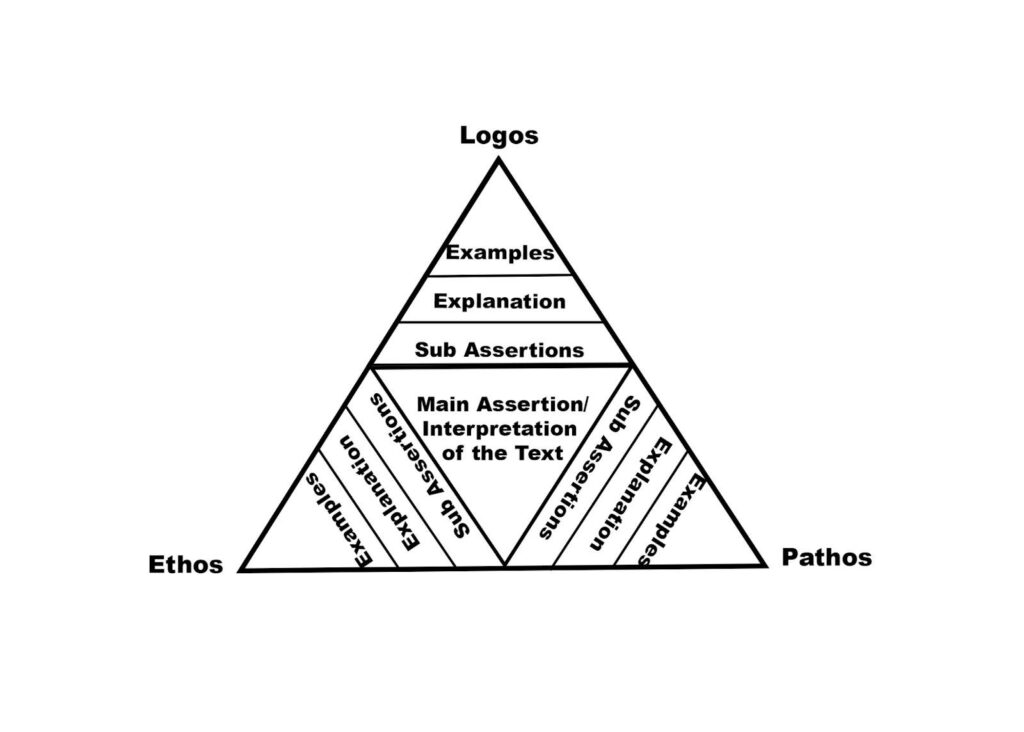
Source = BrianKhudson
Each corner is one of the appeals – ethos, pathos, and logos.
The strongest arguments use all three corners of the triangle. If you only use one or two, your argument might be wobbly, like a stool with a leg missing!
Even though Aristotle lived long ago, his ideas are alive everywhere.
For example,
- A commercial might show a doctor talking about toothpaste (ethos), a child with a big smile (pathos), and say “9 out of 10 dentists recommend it” (logos).
- Or a speech by a leader: they tell their story to build trust, speak to people’s pain or hope, and explain their plan with clear points.
- Or a school essay: a student makes their case using personal experience (ethos), emotional examples (pathos), and strong reasons (logos).
They are the heart of communication today.
In marketing, politics, classrooms, and everyday life, knowing how to use ethos, pathos, and logos helps people become better speakers, writers, and thinkers.
You don’t have to figure it out all on your own.
Undetectable AI Chat can help you break down complex rhetorical concepts just like a teacher or tutor.
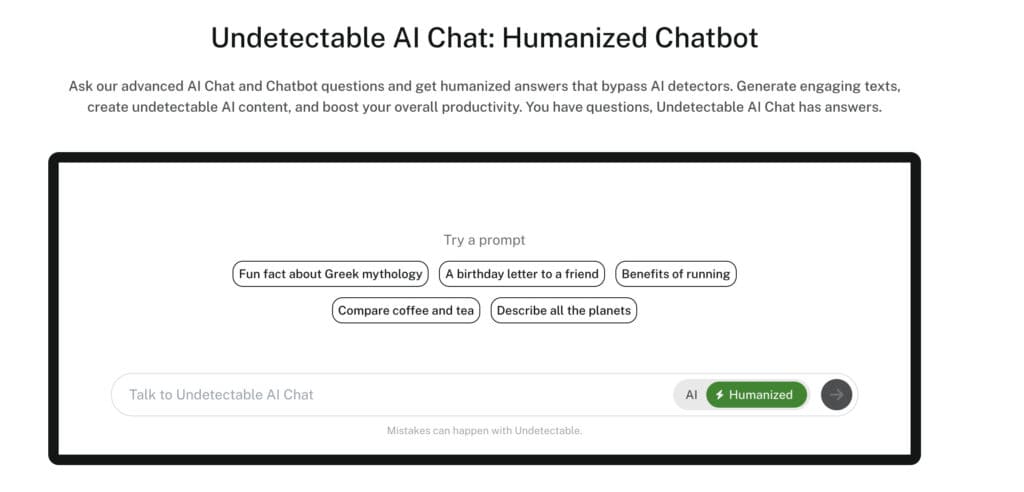
Let’s say you’re stuck on one part, like pathos. You could type:
“Explain pathos in simple terms with a marketing example.”
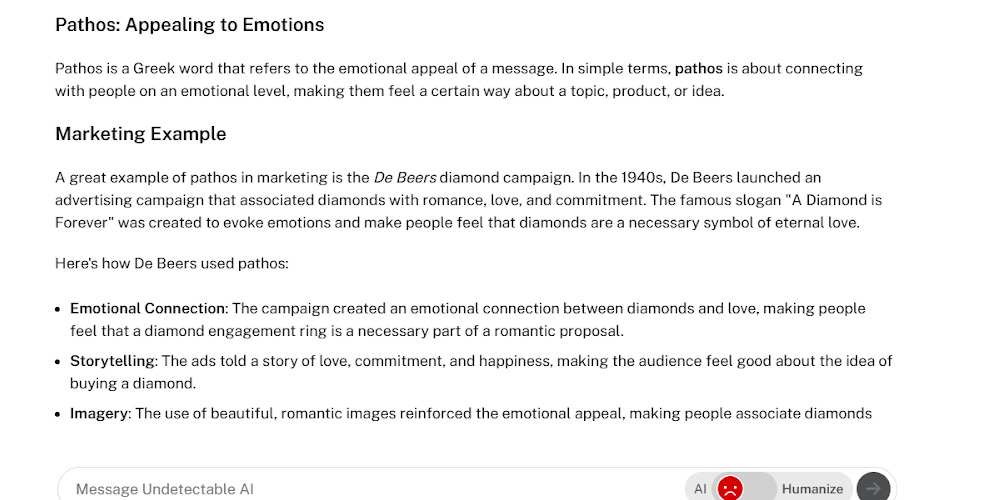
Or you can ask for other type of topic breakdown:
- Write a paragraph that uses ethos to build trust in a health product.
- Give me a pathos example that would connect with parents about school safety.
- Explain logos using an ad for electric cars.
- Compare ethos, pathos, and logos using real lines from a political speech.
- Help me rewrite this paragraph using all three rhetorical appeals.
Ethos: Building Trust and Authority
As mentioned above, “ethos” means “character.”
It is all about trust and authority. It’s the feeling people get that you know what you’re talking about and that they can believe you.
Without ethos, people might not even listen to your ideas. There are two types of ethos.
- Extrinsic ethos is the trust you already have before you even speak.
- Like if you’re a doctor, your titles, degrees, experience, and reputation are your extrinsic ethos.
- Intrinsic ethos is what you build as you speak—your tone, your honesty, your word choice.
- It comes from your tone of voice, your words, confidence, correct grammar, and fair-mind.
Example:
“As a pediatrician with 20 years of experience treating childhood asthma, I’ve seen firsthand how air quality affects children’s lung development. That’s why I recommend HEPA air filters in bedrooms.”
See how powerful that is? If a random person recommended an air filter, you might ignore it.
But a pediatrician with 20 years of experience? Now I’m listening!
Pathos: Appealing to Emotion
Pathos is all about feelings.
We all have cried while watching a movie, or felt angry after hearing a sad story. That was pathos working on us.
The emotions come in many types.
- Some make us feel good, like hope and joy.
- Others make us uncomfortable, like fear or guilt.
Smart speakers and writers know how to use all these feelings.
Pathos works because our brains are wired to respond to feelings even before we think things through logically.
When something touches our heart, we’re more likely to take action.
Good storytellers use special techniques to spark emotions.
- They paint pictures with words so you can see things in your mind.
- They tell stories about real people that stick with you.
- They choose powerful words that hit you right in the feelings. Words like “heartbreaking,” “joyful,” “sacrifice,” and “freedom” stir feelings.
Example,
Look at this charity ad.

Source = LaunchGood
You instantly feel something—guilt, maybe, or compassion. You want to help. That’s pathos doing its job.
Logos: Using Logic and Evidence
Sometimes, feelings aren’t enough. People want proof.
Humans have two thinking systems:
- System 1 = fast, emotional, intuitive (pathos)
- System 2 = slow, logical, analytical (logos)
Logos targets System 2. It’s slower but more trustworthy.
For example,
Let’s say you’re trying to convince someone that smoking is dangerous. You could show a sad story (that’s pathos). But to really prove it, you’d say:
“According to the CDC, smoking increases the risk of heart disease by X%.”
Now they feel something and they know something. That’s strong.
There are three main ways to use logic:
- Deductive reasoning: Starting with a general rule and applying it to a specific case.
- For example, All kids in this school wear uniforms. Maya goes to this school. So, Maya wears a uniform.
- Inductive reasoning: Looking at many examples and finding a pattern.
- For example, You see 10 bees and every one has wings. So, you say: “Looks like all bees have wings.” It might not always be true—but it’s a strong guess based on what you’ve seen.
- Analogical reasoning: Showing how two things are similar.
- For example, Running a business without a plan is like driving without a map. You might go somewhere… but probably not where you meant to.
Logos use elements like data (numbers that show patterns), statistics (facts from studies or research), clear structure (like “If this happens, then that happens.”
Or “Because of this, we now see that…”) to support the argument.
Ethos vs Pathos vs Logos: Key Differences
Let’s talk about the differences between these three conversation tools:
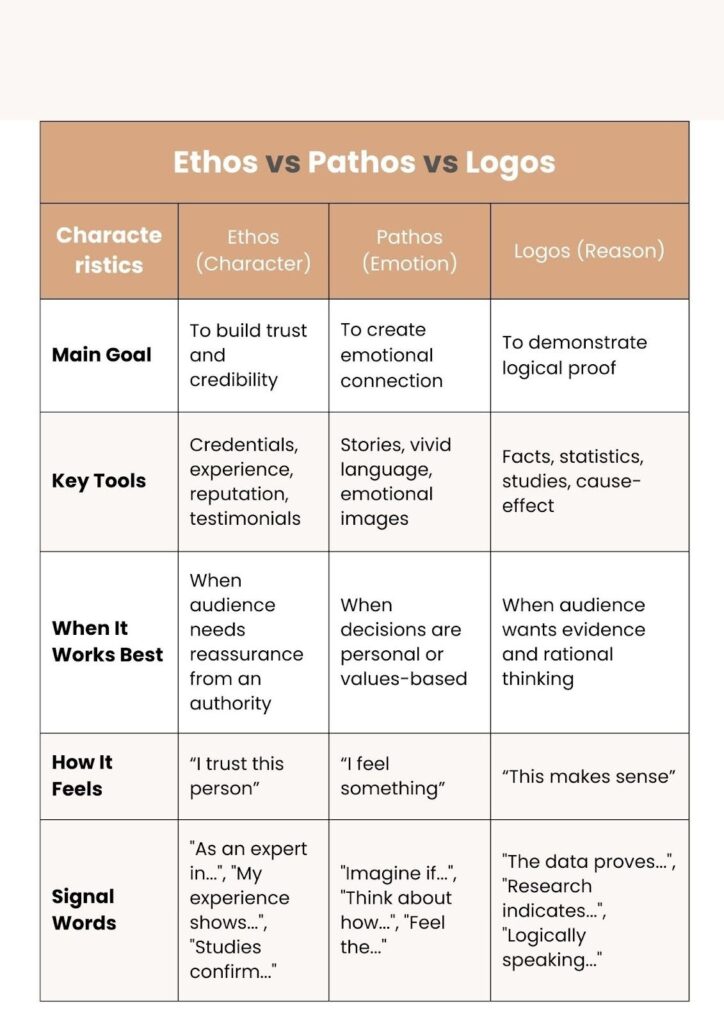
When and How to Use Each
We have learned that the strongest argument has all three components – ethos, pathos, and logos.
But not all types of arguments should have equal proportions of all three. You have to understand certain factors like:
1 – Who You’re Talking To?
You have to understand your audience:
- Let’s say you’re writing for a classroom or a science blog—that’s a formal space. You’d want to lean more on logos (logic and facts), maybe a little ethos too, to show you know what you’re talking about.
- But if you’re posting on Instagram, or telling a personal story, pathos (emotion) might be stronger.
2 – Where Are You Talking?
- Formal places (like school) usually need more logos and ethos
- Informal places (like with friends) might need more pathos
- Written words need stronger logos since people can re-read and think
- Spoken words can use more pathos since your voice and face show emotion
3 – What’s Your Topic About?
Some topics need more of one appeal:
- Health issues need lots of ethos (trusted doctors) and logos (research)
- Animal rights often use pathos (sad puppy pictures)
- Money decisions need strong logos (math and facts)
At the end, we have to use all three to make our arguments strong:
- Start with ethos to show you’re trustworthy
- Use pathos to make people care about your point
- Back it up with logos so they know it makes sense
But be careful.
Sometimes using too much emotion (pathos) in a science report, or quoting too many facts (logos) in a story about human struggle, can feel off.
The trick is to match your tone and message to the moment.
If that feels like a lot to manage—don’t worry.
That’s where an Undetectable AI Essay Writer can help.
If you’re ever unsure how to blend all three appeals or how to shape your writing for the right audience, the AI does it with you.
It builds your essay with the right tone for your audience, a strong persuasive structure, and real examples that match your topic.
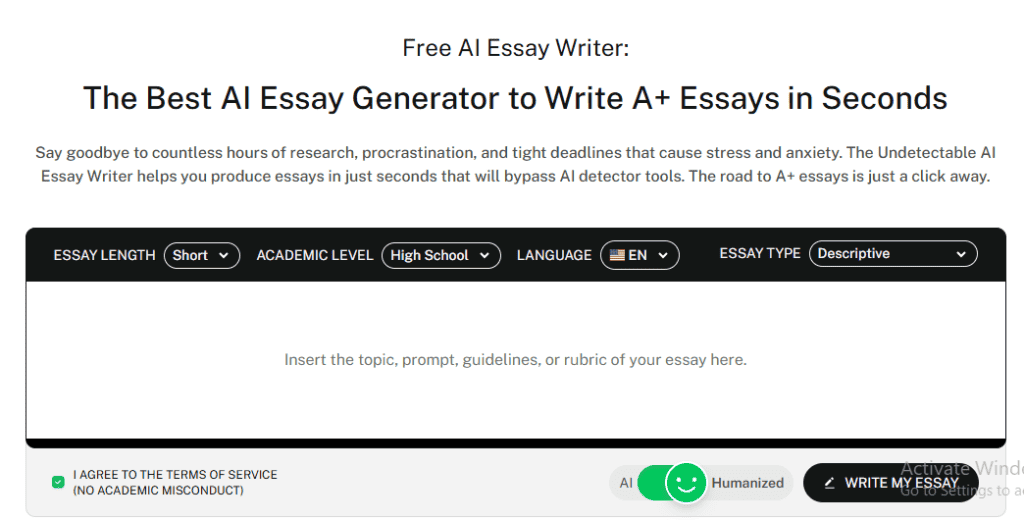
- Log in to the AI Essay Writer using this link.
- Customize the essay parameters—such as word count, preferred writing style, and topic.
- Within seconds, you’ll receive a well-researched, unique, and factually accurate draft ready for review.
Real-World Examples
1 – Martin Luther King’s “I Have a Dream” (Pathos-heavy)
- Pathos:
- “I have a dream that my four little children will one day live in a nation where they will not be judged by the color of their skin but by the content of their character.”
→ Evokes hope and emotional longing for equality.
- “I have a dream that my four little children will one day live in a nation where they will not be judged by the color of their skin but by the content of their character.”
- “Let us not wallow in the valley of despair.”
→ Uses vivid imagery to stir collective determination.
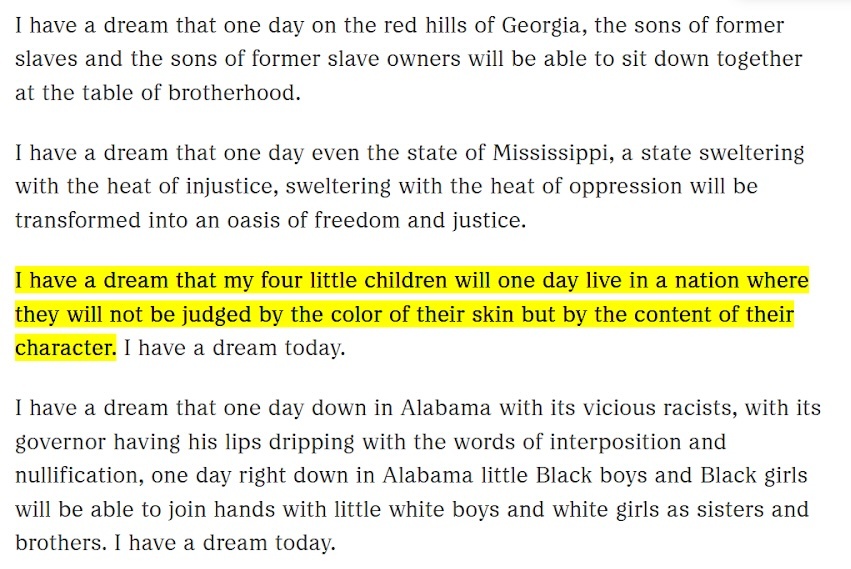
- Ethos:
- References to foundational American documents (“Declaration of Independence”) and religious themes (“God’s children”) establish moral authority.
- Logos:
- “America has defaulted on this promissory note insofar as her citizens of color are concerned.”
→ It compares racial injustice to a financial metaphor (broken promise).
- “America has defaulted on this promissory note insofar as her citizens of color are concerned.”
Read the full transcript of speech here >> ‘I Have a Dream’ speech in its entirety
2 – Steve Jobs’ Stanford Commencement Speech (Ethos + Logos)
- Ethos:
- “I dropped out of Reed College… then stayed around as a drop-in for another 18 months or so before I really quit. So why did I drop out?”
→ Personal vulnerability builds credibility through lived experience.
- “Death is very likely the single best invention of Life.”
→ Authority from facing mortality (cancer survivor).
- Logos:
- “You can’t connect the dots looking forward; you can only connect them looking backward.”
→ Logical argument about hindsight and trust in the journey.
- “You can’t connect the dots looking forward; you can only connect them looking backward.”
- “Stay Hungry. Stay Foolish.”
→ Concise, rational advice for innovation.
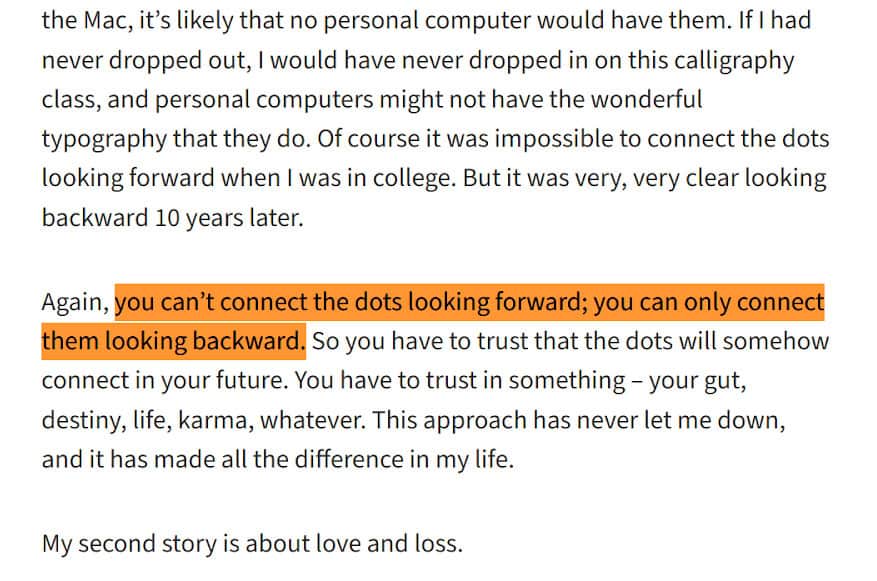
- Pathos:
- “My biological mother… wanted me to be adopted by college graduates.”
→ Emotional backstory to humanize his journey.
- “My biological mother… wanted me to be adopted by college graduates.”
Read the full transcript of speech here >> ‘You’ve got to find what you love,’ Jobs says
3 – Michael Jordan Endorsement of Nike (Ethos)
- “Just Do It” (tagline) + Jordan’s image.
→ Leverages Jordan’s athletic authority (ethos) to persuade viewers to trust Nike’s quality.

Source = Krows Digital
Give our AI Detector and Humanizer a try in the widget below!
FAQs: Ethos, Pathos, Logos
Can one piece of writing use all three?
Yes. Combining ethos, pathos, and logos often makes your message stronger and more persuasive.
Is one mode better than the others?
Not always. It depends on what you’re trying to say and who you’re speaking to.
How do I know which one to use?
Match your goal (inform, inspire, convince) with your audience’s mindset (emotional, skeptical, curious).
Final Thoughts: Mastering Persuasion
So… what now?
You’ve learned about ethos, pathos, and logos—the tools that make words powerful.
But just knowing about them isn’t enough. Like any skill, persuasion takes practice.
Try using each appeal in your own writing or conversations.
See how it feels when you add a personal story. Or when you backup your ideas with facts. Or when you speak in a way that builds trust.
And here’s something important: persuasion should always be used with care.
Being honest, fair, and respectful matters.
The best persuaders don’t trick people—they help them think clearly and feel understood.
As the world moves more online, the way we use these tools is changing.
Emails, ads, videos, social media… Persuasion is everywhere. That’s why learning it now gives you an edge, not just in school—but in life.
Want to go deeper? Check out books, take a course, or just pay closer attention when someone convinces you of something. Ask yourself:
“Was that ethos? Pathos? Logos?”
Once you start noticing it, you’ll see it everywhere—from TikTok to TED Talks.
And who knows? Maybe one day, you’ll be that person everyone listens to at the table.
The one who always seems to say it just right.
Want to put ethos, pathos, and logos into action?
Try tools like Undetectable’s AI Chat and Essay Writer to sharpen your arguments, refine your tone, and strengthen your persuasive writing.
